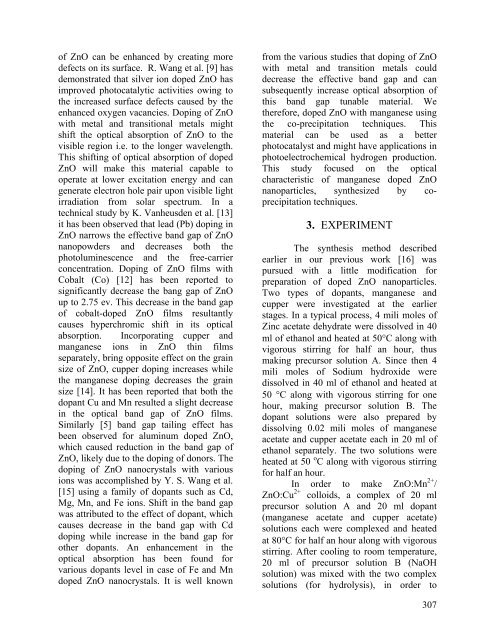Synthesis and Optical Properties of Transition Metal Doped ZnO ...
Synthesis and Optical Properties of Transition Metal Doped ZnO ...
Synthesis and Optical Properties of Transition Metal Doped ZnO ...
You also want an ePaper? Increase the reach of your titles
YUMPU automatically turns print PDFs into web optimized ePapers that Google loves.
<strong>of</strong> <strong>ZnO</strong> can be enhanced by creating more<br />
defects on its surface. R. Wang et al. [9] has<br />
demonstrated that silver ion doped <strong>ZnO</strong> has<br />
improved photocatalytic activities owing to<br />
the increased surface defects caused by the<br />
enhanced oxygen vacancies. Doping <strong>of</strong> <strong>ZnO</strong><br />
with metal <strong>and</strong> transitional metals might<br />
shift the optical absorption <strong>of</strong> <strong>ZnO</strong> to the<br />
visible region i.e. to the longer wavelength.<br />
This shifting <strong>of</strong> optical absorption <strong>of</strong> doped<br />
<strong>ZnO</strong> will make this material capable to<br />
operate at lower excitation energy <strong>and</strong> can<br />
generate electron hole pair upon visible light<br />
irradiation from solar spectrum. In a<br />
technical study by K. Vanheusden et al. [13]<br />
it has been observed that lead (Pb) doping in<br />
<strong>ZnO</strong> narrows the effective b<strong>and</strong> gap <strong>of</strong> <strong>ZnO</strong><br />
nanopowders <strong>and</strong> decreases both the<br />
photoluminescence <strong>and</strong> the free-carrier<br />
concentration. Doping <strong>of</strong> <strong>ZnO</strong> films with<br />
Cobalt (Co) [12] has been reported to<br />
significantly decrease the bang gap <strong>of</strong> <strong>ZnO</strong><br />
up to 2.75 ev. This decrease in the b<strong>and</strong> gap<br />
<strong>of</strong> cobalt-doped <strong>ZnO</strong> films resultantly<br />
causes hyperchromic shift in its optical<br />
absorption. Incorporating cupper <strong>and</strong><br />
manganese ions in <strong>ZnO</strong> thin films<br />
separately, bring opposite effect on the grain<br />
size <strong>of</strong> <strong>ZnO</strong>, cupper doping increases while<br />
the manganese doping decreases the grain<br />
size [14]. It has been reported that both the<br />
dopant Cu <strong>and</strong> Mn resulted a slight decrease<br />
in the optical b<strong>and</strong> gap <strong>of</strong> <strong>ZnO</strong> films.<br />
Similarly [5] b<strong>and</strong> gap tailing effect has<br />
been observed for aluminum doped <strong>ZnO</strong>,<br />
which caused reduction in the b<strong>and</strong> gap <strong>of</strong><br />
<strong>ZnO</strong>, likely due to the doping <strong>of</strong> donors. The<br />
doping <strong>of</strong> <strong>ZnO</strong> nanocrystals with various<br />
ions was accomplished by Y. S. Wang et al.<br />
[15] using a family <strong>of</strong> dopants such as Cd,<br />
Mg, Mn, <strong>and</strong> Fe ions. Shift in the b<strong>and</strong> gap<br />
was attributed to the effect <strong>of</strong> dopant, which<br />
causes decrease in the b<strong>and</strong> gap with Cd<br />
doping while increase in the b<strong>and</strong> gap for<br />
other dopants. An enhancement in the<br />
optical absorption has been found for<br />
various dopants level in case <strong>of</strong> Fe <strong>and</strong> Mn<br />
doped <strong>ZnO</strong> nanocrystals. It is well known<br />
from the various studies that doping <strong>of</strong> <strong>ZnO</strong><br />
with metal <strong>and</strong> transition metals could<br />
decrease the effective b<strong>and</strong> gap <strong>and</strong> can<br />
subsequently increase optical absorption <strong>of</strong><br />
this b<strong>and</strong> gap tunable material. We<br />
therefore, doped <strong>ZnO</strong> with manganese using<br />
the co-precipitation techniques. This<br />
material can be used as a better<br />
photocatalyst <strong>and</strong> might have applications in<br />
photoelectrochemical hydrogen production.<br />
This study focused on the optical<br />
characteristic <strong>of</strong> manganese doped <strong>ZnO</strong><br />
nanoparticles, synthesized by coprecipitation<br />
techniques.<br />
3. EXPERIMENT<br />
The synthesis method described<br />
earlier in our previous work [16] was<br />
pursued with a little modification for<br />
preparation <strong>of</strong> doped <strong>ZnO</strong> nanoparticles.<br />
Two types <strong>of</strong> dopants, manganese <strong>and</strong><br />
cupper were investigated at the earlier<br />
stages. In a typical process, 4 mili moles <strong>of</strong><br />
Zinc acetate dehydrate were dissolved in 40<br />
ml <strong>of</strong> ethanol <strong>and</strong> heated at 50C along with<br />
vigorous stirring for half an hour, thus<br />
making precursor solution A. Since then 4<br />
mili moles <strong>of</strong> Sodium hydroxide were<br />
dissolved in 40 ml <strong>of</strong> ethanol <strong>and</strong> heated at<br />
50 C along with vigorous stirring for one<br />
hour, making precursor solution B. The<br />
dopant solutions were also prepared by<br />
dissolving 0.02 mili moles <strong>of</strong> manganese<br />
acetate <strong>and</strong> cupper acetate each in 20 ml <strong>of</strong><br />
ethanol separately. The two solutions were<br />
heated at 50 o C along with vigorous stirring<br />
for half an hour.<br />
In order to make <strong>ZnO</strong>:Mn 2+ /<br />
<strong>ZnO</strong>:Cu 2+ colloids, a complex <strong>of</strong> 20 ml<br />
precursor solution A <strong>and</strong> 20 ml dopant<br />
(manganese acetate <strong>and</strong> cupper acetate)<br />
solutions each were complexed <strong>and</strong> heated<br />
at 80C for half an hour along with vigorous<br />
stirring. After cooling to room temperature,<br />
20 ml <strong>of</strong> precursor solution B (NaOH<br />
solution) was mixed with the two complex<br />
solutions (for hydrolysis), in order to<br />
307
















